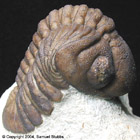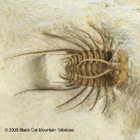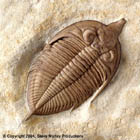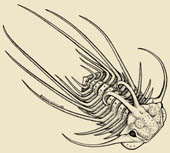 |
BLACK CAT MOUNTAIN TRILOBITESTrilobite Fossil Preparation |
|
| P.O. Box 25, Clarita Oklahoma 74535 email: BugsROK2021@gmail.com |
|
"Click On Any Image For A Larger View"
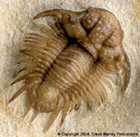 | The trilobite fossils found in the devonian formations of Oklahoma, are some of the most beautiful fossils found anywhere in the world. These unique fossils grace the collections of major museums and private collectors all around the globe. But the specimens seen in most display cases, have gone through a major transformation, from what has laid hidden in 354 million year old rocks, to the pristine specimen you see on exhibit. |
| The story actually begins in the field, where the layers of rock containing the fossils are found. Many arduous hours are spent exposing the trilobite containing layers, and then breaking and splitting the tough limestone, to expose faint hints of what may lay within. The field work is done during the summer months, and literally tons of rock is removed and broken using rock and sledge hammers. Bob Carroll is shown at the right, breaking and inspecting fragments of the Haragan Formation. | 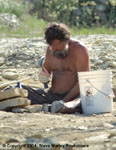 |
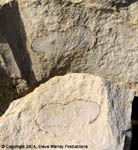 | Once a piece of limestone with a trilobite within is broken just right, the outline of the fossil is visible. The specimen shown at the left has a fairly obvious outline, more often just a hint of the trilobite is visible. At this point all of the related pieces are wrapped together for safe keeping until preparation begins in the lab. Once the specimen arrives at the prep lab, it is unwrapped, and all of the pieces are carefully glued back to their original unbroken position. The location of the "Bug" in the matrix is marked on the rock so that the preparator knows where to begin working on the piece. |
| Once the adhesive has firmly set, and the matrix containing the trilobite fossil is stable, then the first part of the preparation process begins. Using an Air-Scribe, the matrix is carefully chiseled away down to the level of the trilobite. The preparator follows the anatomy of the fossil, leaving just a thin layer of the matrix on the fossil, so that the animal's delicate shell is not damaged. The surface of the matrix may also be shaped at this point, and once the condition and orientation of the specimen is fully known, a base may be cut and polished for the finished piece to sit correctly in the display case. | 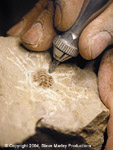 |
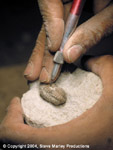 | Once the roughing-out is completed, and the shaping of the matrix has been done, final preparation begins with the use of a commercial abrasive unit. These machines are like miniature sand blasters, but use a lot less air pressure, and much finer abrasive particles such as sodium bicarbonate and aluminum oxide. At this stage, the preparator needs to use all of his or her skills to avoid doing any damage to the specimen. The last layers of matrix covering the trilobite are removed, and the surface of the matrix may be textured to create a museum quality display specimen. |
| It may take anywhere from 5 to 24 hours to finish prepping even a simple trilobite such as this excellent Kainops raymondi shown on the right. Complicated specimens such as a Dicranurus hamatus or Ceratonurus sp. may take even longer to complete. Presentation and detailed labeling make for a truly exquisite specimen, ready for display and study. | 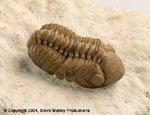 |
|
|
|
| Black Cat Mountain Trilobites - World Class Oklahoma Trilobites |
|



